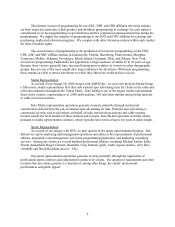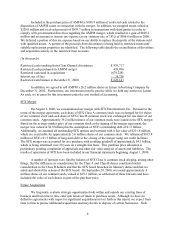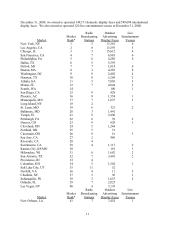iHeartMedia 2000 Annual Report Download - page 16
Download and view the complete annual report
Please find page 16 of the 2000 iHeartMedia annual report below. You can navigate through the pages in the report by either clicking on the pages listed below, or by using the keyword search tool below to find specific information within the annual report.
16
• shifts in population and other demographics;
• the level of competition for advertising dollars;
• fluctuations in operating costs;
• technological changes and innovations;
• changes in labor conditions; and
• changes in governmental regulations and policies and actions of federal regulatory bodies.
Regulation of Our Business
Existing Regulation and 1996 Legislation
Television and radio broadcasting are subject to the jurisdiction of the FCC under the
Communications Act of 1934. The Communications Act prohibits the operation of a television or radio
broadcasting station except under a license issued by the FCC and empowers the FCC, among other
things, to:
• issue, renew, revoke and modify broadcasting licenses;
• assign frequency bands;
• determine stations’ frequencies, locations, and power;
• regulate the equipment used by stations;
• adopt other regulations to carry out the provisions of the Communications Act;
• impose penalties for violation of such regulations; and
• impose fees for processing applications and other administrative functions.
The Communications Act prohibits the assignment of a license or the transfer of control of a licensee
without prior approval of the FCC. Under the Communications Act, the FCC also regulates certain
aspects of the operation of cable television systems and other electronic media that compete with
broadcasting stations.
The Telecommunications Act of 1996 represented the most comprehensive overhaul of the
country’ s telecommunications laws in more than 60 years. The Communications Act originated at a time
when telephone and broadcasting technologies were quite distinct and addressed different consumer
needs. As a consequence, both the statute and its implementing regulatory scheme were designed to
compartmentalize the various sectors of the telecommunications industry. The 1996 Act removed or
relaxed the statutory barriers to telephone company entry into the video programming delivery business,
to cable company provision of telephone service, and to common ownership of broadcast television and
cable properties.
The 1996 Act also significantly changed both the process for renewal of broadcast station licenses
and the broadcast ownership rules. The 1996 Act established a “two-step” renewal process that limits the
FCC’ s discretion to consider applications filed in competition with an incumbent’ s renewal application.
The 1996 Act also substantially liberalized the national broadcast ownership rules, eliminating the
national radio limits and easing the national restrictions on TV ownership. The 1996 Act also relaxed
local radio ownership restrictions, but left local TV ownership restrictions in place pending further FCC
review.
This new regulatory flexibility has engendered aggressive local, regional, and/or national
acquisition campaigns. Removal of previous station ownership limitations on leading media companies,
such as existing networks and major station groups, increased sharply the competition for and the prices
of attractive stations.
























